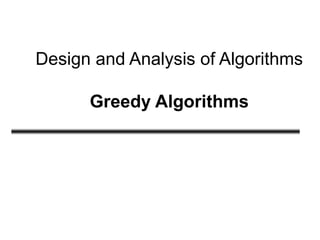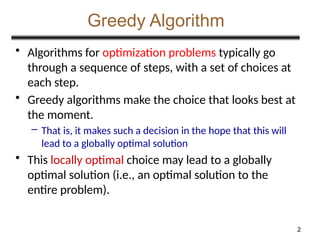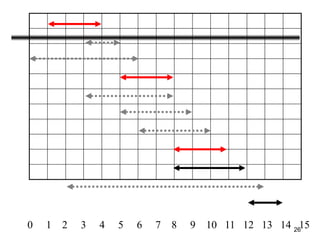Design and Analysis of Algorithms (Greedy Algorithm)
- 1. Design and Analysis of Algorithms Greedy Algorithms
- 2. 2 Greedy Algorithm • Algorithms for optimization problems typically go through a sequence of steps, with a set of choices at each step. • Greedy algorithms make the choice that looks best at the moment. – That is, it makes such a decision in the hope that this will lead to a globally optimal solution • This locally optimal choice may lead to a globally optimal solution (i.e., an optimal solution to the entire problem).
- 3. 3 When can we use Greedy algorithms? We can use a greedy algorithm when the following are true: 1) The greedy choice property: A A(greedy) choice. 2) The optimal substructure property: The optimal solution contains within its optimal solutions to subproblems.
- 4. 4 An Activity Selection Problem (Conference Scheduling Problem) • Input: A set of activities S = {a1,…, an} • We have n proposed activities that wish to use a resource, such as a lecture hall, which can serve only one activity at a time. • Each activity has start time and a finish time –ai=(si, fi) • Two activities are compatible if and only if their interval does not overlap • Output: a maximum-size subset of mutually compatible activities
- 5. 5 The Activity Selection Problem • Here are a set of start and finish times • What is the maximum number of activities that can be completed? • {a3, a9, a11} can be completed • But so can {a1, a4, a8’ a11} which is a larger set • But it is not unique, consider {a2, a4, a9’ a11}
- 6. 6 Input: list of time-intervals L Output: a non-overlapping subset S of the intervals Objective: maximize |S| 3,7 2,4 5,8 6,9 1,11 10,12 0,3 The Activity Selection Problem
- 7. 7 Input: list of time-intervals L Output: a non-overlapping subset S of the intervals Objective: maximize |S| 3,7 2,4 5,8 6,9 1,11 10,12 0,3 Answer = 3 The Activity Selection Problem
- 8. 8 Algorithm 1: 1. sort the activities by the starting time 2. pick the first activity “a” 3. remove all activities conflicting with “a” 4. repeat The Activity Selection Problem
- 9. 9 Algorithm 1: 1. sort the activities by the starting time 2. pick the first activity “a” 3. remove all activities conflicting with “a” 4. repeat The Activity Selection Problem
- 10. 10 Algorithm 1: 1. sort the activities by the starting time 2. pick the first activity “a” 3. remove all activities conflicting with “a” 4. repeat The Activity Selection Problem
- 11. 11 Algorithm 2: 1. sort the activities by length 2. pick the shortest activity “a” 3. remove all activities conflicting with “a” 4. repeat The Activity Selection Problem
- 12. 12 Algorithm 2: 1. sort the activities by length 2. pick the shortest activity “a” 3. remove all activities conflicting with “a” 4. repeat The Activity Selection Problem
- 13. 13 Algorithm 2: 1. sort the activities by length 2. pick the shortest activity “a” 3. remove all activities conflicting with “a” 4. repeat The Activity Selection Problem
- 14. 14 Algorithm 3: 1. sort the activities by ending time 2. pick the activity which ends first 3. remove all activities conflicting with a 4. repeat The Activity Selection Problem
- 15. 15 The Activity Selection Problem Algorithm 3: 1. sort the activities by ending time 2. pick the activity which ends first 3. remove all activities conflicting with a 4. repeat
- 16. 16 The Activity Selection Problem Algorithm 3: 1. sort the activities by ending time 2. pick the activity which ends first 3. remove all activities conflicting with a 4. repeat
- 17. 17 The Activity Selection Problem Algorithm 3: 1. sort the activities by ending time 2. pick the activity which ends first 3. remove all activities conflicting with a 4. repeat
- 18. 18 Algorithm 3: 1. sort the activities by ending time 2. pick the activity “a” which ends first 3. remove all activities conflicting with “a” 4. repeat Theorem: Algorithm 3 gives an optimal solution to the activity selection problem. The Activity Selection Problem
- 19. 19 Activity Selection Algorithm Idea: At each step, select the activity with the smallest finish time that is compatible with the activities already chosen. Greedy-Activity-Selector(s, f) n <- length[s] A <- {1} {Automatically select first activity} j <- 1 {Last activity selected so far} for i <- 2 to n do if si >= fj then A <- A U {i} {Add activity i to the set} j <- i {record last activity added} return A The idea is to always select the activity with the earliest finishing time, as it will free up the most time for other activities.
- 20. 20 The Activity Selection Problem • Here are a set of start and finish times • What is the maximum number of activities that can be completed? • {a3, a9, a11} can be completed • But so can {a1, a4, a8’ a11} which is a larger set • But it is not unique, consider {a2, a4, a9’ a11}
- 21. 21 Interval Representation Added in optimal Solution Not Observed yet Removed from the list
- 22. 22 0 1 2 3 4 5 6 7 8 9 10 11 12 13 14 15
- 23. 23 0 1 2 3 4 5 6 7 8 9 10 11 12 13 14 15
- 24. 24 0 1 2 3 4 5 6 7 8 9 10 11 12 13 14 15
- 25. 25 0 1 2 3 4 5 6 7 8 9 10 11 12 13 14 15
- 26. 26 0 1 2 3 4 5 6 7 8 9 10 11 12 13 14 15
- 27. 27 0 1 2 3 4 5 6 7 8 9 10 11 12 13 14 15
- 28. 28 0 1 2 3 4 5 6 7 8 9 10 11 12 13 14 15
- 29. 29 Why this Algorithm is Optimal? • We will show that this algorithm uses the following properties • The problem has the optimal substructure property • The algorithm satisfies the greedy-choice property • Thus, it is Optimal
- 30. 30 Optimal Substructure Property • Base Case: For the smallest subproblem of size 1 (only one activity), the optimal solution is trivially the activity itself. • Inductive Hypothesis: Assume that we have already proven that the optimal solution can be constructed for any subset of activities with size k, where 1 ≤ k ≤ n - 1.
- 31. 31 Optimal Substructure Property Inductive Step: Now we want to prove that the optimal solution can be constructed for a subset of activities with size k + 1. Let's consider the set of activities {A1, A2, ..., Ak+1}. Since the activities are sorted by finishing times, the last activity in this set, Ak+1, will have the maximum finish time among all activities. We have two cases: First case: Activity Ak+1 is included in the optimal solution. • In this case, we need to find an optimal solution for the remaining activities {A1, A2, ..., Ak} that are non-overlapping with Ak+1. • By our inductive hypothesis, we know that an optimal solution can be constructed for these k activities. • Combining Ak+1 with this optimal solution gives us an optimal solution for the entire set {A1, A2, ..., Ak+1}.
- 32. 32 Optimal Substructure Property First case: Activity Ak+1 is included in the optimal solution. • In this case, we need to find an optimal solution for the remaining activities {A1, A2, ..., Ak} that are non-overlapping with Ak+1. • By our inductive hypothesis, we know that an optimal solution can be constructed for these k activities. • Combining Ak+1 with this optimal solution gives us an optimal solution for the entire set {A1, A2, ..., Ak+1} Second Case: Activity Ak+1 is not included in the optimal solution. • In this case, we simply need to find an optimal solution for the activities {A1, A2, ..., Ak}, which we have already assumed possible by our inductive hypothesis. Since we've covered both cases, we can conclude that the optimal solution for the set {A1, A2, ..., Ak+1} can be constructed from the optimal solutions of the smaller subproblems {A , A , ..., A },
- 33. 33 Greedy-Choice Property • Show there is an optimal solution that begins with a greedy choice (with activity 1, which as the earliest finish time) • Suppose A S in an optimal solution – Order the activities in A by finish time. The first activity in A is k • If k = 1, the schedule A begins with a greedy choice • If k 1, show that there is an optimal solution B to S that begins with the greedy choice, activity 1 – Let B = A – {k} {1} • f1 fk activities in B are disjoint (compatible) • B has the same number of activities as A • Thus, B is optimal
- 34. Example of Greedy Algorithm • Fractional Knapsack • Huffman Coding • Minimum Spanning Tree – Prims and Kruskal’s • Activity Selection Problem • Dijkstra’s Shortest Path Algorithm • Network Routing • Job sequencing with deadlines • Coin change problems • Graph Coloring: Greedy algorithms can be used to color a graph (though not necessarily optimally) by assigning the next available color to a vertex. 34
- 35. 35 Designing Greedy Algorithms 1. Cast the optimization problem as one for which: • we make a choice and are left with only one subproblem to solve 2. Prove the GREEDY CHOICE • that there is always an optimal solution to the original problem that makes the greedy choice 3. Prove the OPTIMAL SUBSTRUCTURE: • the greedy choice + an optimal solution to the resulting subproblem leads to an optimal solution
- 36. 36 Example: Making Change • Instance: amount (in cents) to return to customer • Problem: do this using fewest number of coins • Example: – Assume that we have an unlimited number of coins of various denominations: – 1c (pennies), 5c (nickels), 10c (dimes), 25c (quarters), 1$ (loonies) – Objective: Pay out a given sum $5.64 with the smallest number of coins possible.
- 37. 37 The Coin Changing Problem • Assume that we have an unlimited number of coins of various values: • 1c (pennies), 5c (nickels), 10c (dimes), 25c (quarters), 1$ (loonies) • Objective: Pay out a given sum S with the smallest number of coins possible. • The greedy coin changing algorithm: • This is a (m) algorithm where m = number of values. while S > 0 do c := value of the largest coin no larger than S; num := S / c; pay out num coins of value c; S := S - num*c;
- 38. 38 Example: Making Change • E.g.: $5.64 = $2 +$2 + $1 + .25 + .25 + .10 + .01 + .01 + .01 +.01
- 39. 39 Making Change – A big problem • Example 2: Coins are valued $.30, $.20, $.05, $.01 – Does not have greedy-choice property, since $.40 is best made with two $.20’s, but the greedy solution will pick three coins (which ones?)
- 40. 40 The Fractional Knapsack Problem • Given: A set S of n items, with each item i having – bi - a positive benefit – wi - a positive weight • Goal: Choose items with maximum total benefit but with weight at most W. • If we are allowed to take fractional amounts, then this is the fractional knapsack problem. – In this case, we let xi denote the amount we take of item i – Objective: maximize – Constraint: S i i i i w x b ) / ( i i S i i w x W x 0 ,
- 41. 41 Example • Given: A set S of n items, with each item i having – bi - a positive benefit – wi - a positive weight • Goal: Choose items with maximum total benefit but with total weight at most W. Weight: Benefit: 1 2 3 4 5 4 ml 8 ml 2 ml 6 ml 1 ml $12 $32 $40 $30 $50 Items: Value: 3 ($ per ml) 4 20 5 50 10 ml Solution: P • 1 ml of 5 50$ • 2 ml of 3 40$ • 6 ml of 4 30$ • 1 ml of 2 4$ “knapsack”
- 42. 42 The Fractional Knapsack Algorithm • Greedy choice: Keep taking item with highest value (benefit to weight ratio) – Since Algorithm fractionalKnapsack(S, W) Input: set S of items w/ benefit bi and weight wi; max. weight W Output: amount xi of each item i to maximize benefit w/ weight at most W for each item i in S xi 0 vi bi / wi {value} w 0 {total weight} while w < W remove item i with highest vi xi min{wi , W - w} w w + min{wi , W - w} S i i i i S i i i i x w b w x b ) / ( ) / (
- 43. 43 The Fractional Knapsack Algorithm • Running time: Given a collection S of n items, such that each item i has a benefit bi and weight wi, we can construct a maximum-benefit subset of S, allowing for fractional amounts, that has a total weight W in O(nlogn) time. – Use heap-based priority queue to store S – Removing the item with the highest value takes O(logn) time – In the worst case, need to remove all items


















![19
Activity Selection Algorithm
Idea: At each step, select the activity with the smallest finish time
that is compatible with the activities already chosen.
Greedy-Activity-Selector(s, f)
n <- length[s]
A <- {1} {Automatically select first
activity}
j <- 1 {Last activity selected so far}
for i <- 2 to n do
if si >= fj then
A <- A U {i} {Add activity i to the set}
j <- i {record last activity added}
return A
The idea is to always select the activity with the earliest finishing
time, as it will free up the most time for other activities.](https://image.slidesharecdn.com/lecture9greedy-250224160307-533fb871/85/Design-and-Analysis-of-Algorithms-Greedy-Algorithm-19-320.jpg)























